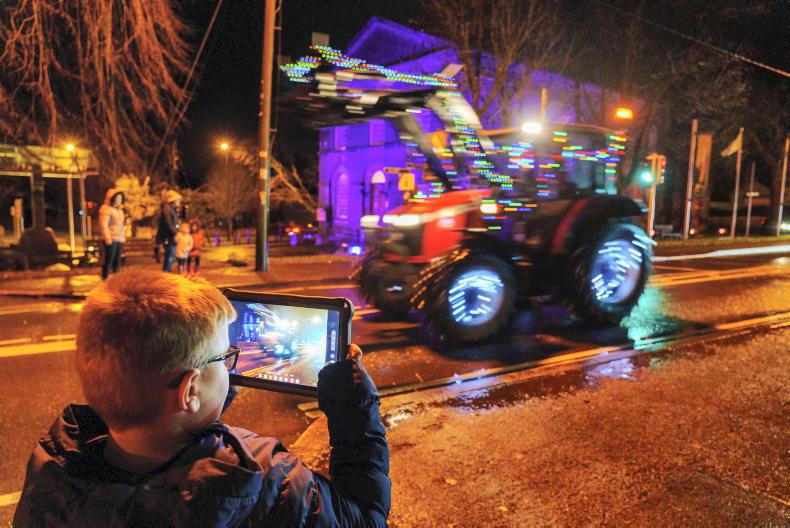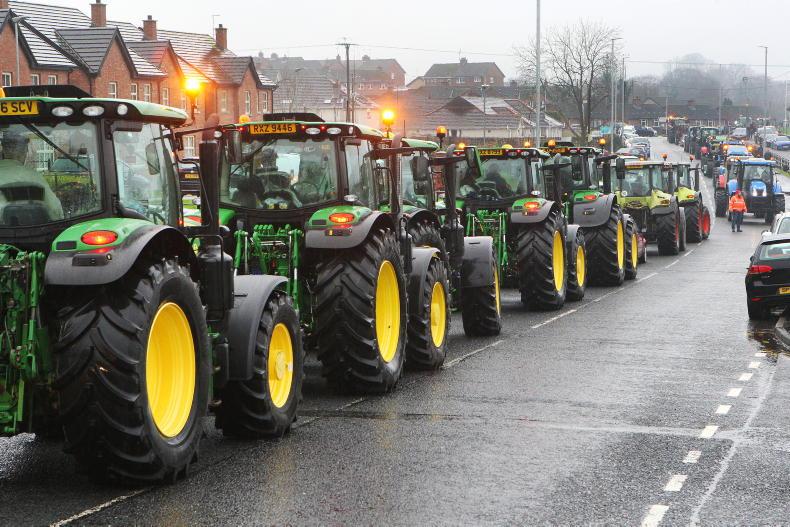As I write I am looking out the big window in my kitchen at my birdfeeder, perhaps the best investment that I have ever made. It is a humble Christmas present that I have gifted to family and friends over the years in the wish that they can experience the simple joy of watching the small birds, chaffinches, blue tits, sparrows, and many others flitting between the feeders. There is no doubt that this passion came from my late parents, who loved the small birds. Each year my father printed his own Christmas cards and included on the back of each a little reminder: “Don’t forget to feed the birds”.
Santa’s robin
Every now and again a charm of long-tailed tits arrives while the colourful siskins, goldcrests, bullfinches, and others offer unexpected moments of delight. Despite such a spectacle, the small bird that is always deep in our hearts and the one most conspicuous at this time of the year is the little robin. I am looking at him now, underneath the big feeder, picking at the little morsels of peanuts on the ground and he stops, looks up and fixes me with his inquisitive eye. I can hear my mother, Eleanor, reminding my brothers and sister that “Santa’s robin is watching you”. Long before “Elf-on-the-Shelf” ever entered the modern Christmas, it was Santa’s robin who was flying up and down to the North Pole to tell of our childhood antics.
Robins are very tame and friendly and well used to human company. Anyone digging in the garden
The drawing that Shane's father would include on the back of the family Christmas cards
will have been accompanied at close quarters by their own robin, delighted with the fresh worms in the up-turned soil. Robins stay close to the house and will often cross the threshold. I knew an old man from Macroom, Tim-the Lodge, who took great delight in coaxing his robin into the kitchen each morning, throwing a few crumbs by the open door. It is their red breast, made brighter and more conspicuous at this time of the year by the early morning blankets of cold frost and the occasional dusting of snow, that single them out.
How the robin got his red breast
Irish folklore has a host of accounts as to how the robin acquired his red breast. One account tells that the small robin tried to help Christ on the cross and while trying to remove the crown of thorns and the nails, his breast was covered with blood. In the context of Christmas, there is the belief that in the stable in Bethlehem there was a brazier keeping the baby Jesus warm and it was going out and not giving off much heat.
The Robin Redbreast and the Wren Are God Almighty’s Cock and Hen
The robin and the wren were close by and the robin jumped up on the edge of the brazier and flapped his little wings to fan the flames and bring on the heat. In so doing, his breast was scorched a deep red colour and so it has been since. For many, the inaction of the wren on this occasion justified the hunting of the wren on Stephen’s Day. Having said that, both birds were considered very special and the robin is most often spoken of as a male and the wren as a female in the celebrated phrase: “The Robin Redbreast and the Wren Are God Almighty’s Cock and Hen.”
Yet another account of the robin’s red breast involves the flight into Egypt when Mary, Joseph, the baby Jesus, and their trusty donkey – with its cross on its back ever since – were trying to escape from Herod and the on-going slaughter of the innocents. As Mary had just given birth, she left a small trail of droplets of blood, which Herod’s soldiers were following. The robin cleverly fell on each droplet absorbing the blood into his breast and so allowing the holy family to escape. In appreciation, Mary bestowed the robin with eggs that are a wonderful, radiant blue colour. The robin is protected at all levels in our folk tradition. In a time when people used to collect birds’ eggs, the robin’s blue eggs were forbidden and anyone who stole them suffered from burning pain in their hands.
Throw a few crumbs
In years gone by, during winter, some people used small wooden bird cribs to trap small birds such as thrushes, blackbirds, skylarks and linnets as an extra source of food. When the bird went under the crib, it would fall and trap them inside. If a robin was found in the crib, they would pluck out one tail feather and leave it go. The governing phrase was “A Robin Redbreast in a Cage, Puts God Almighty in a Rage.”
So, this Christmas, pay special attention to this special Christmas bird, Santa’s robin and throw him a few crumbs from the Christmas cake.
Shane Lehane is a folklorist who works in UCC and Cork College of FET, Tramore Road Campus. Contact: shane.lehane@csn.ie
Read more
Folklore: Irish pancakes – different to the French counterparts
Folklore with Shane Lehane: the bog in May
As I write I am looking out the big window in my kitchen at my birdfeeder, perhaps the best investment that I have ever made. It is a humble Christmas present that I have gifted to family and friends over the years in the wish that they can experience the simple joy of watching the small birds, chaffinches, blue tits, sparrows, and many others flitting between the feeders. There is no doubt that this passion came from my late parents, who loved the small birds. Each year my father printed his own Christmas cards and included on the back of each a little reminder: “Don’t forget to feed the birds”.
Santa’s robin
Every now and again a charm of long-tailed tits arrives while the colourful siskins, goldcrests, bullfinches, and others offer unexpected moments of delight. Despite such a spectacle, the small bird that is always deep in our hearts and the one most conspicuous at this time of the year is the little robin. I am looking at him now, underneath the big feeder, picking at the little morsels of peanuts on the ground and he stops, looks up and fixes me with his inquisitive eye. I can hear my mother, Eleanor, reminding my brothers and sister that “Santa’s robin is watching you”. Long before “Elf-on-the-Shelf” ever entered the modern Christmas, it was Santa’s robin who was flying up and down to the North Pole to tell of our childhood antics.
Robins are very tame and friendly and well used to human company. Anyone digging in the garden
The drawing that Shane's father would include on the back of the family Christmas cards
will have been accompanied at close quarters by their own robin, delighted with the fresh worms in the up-turned soil. Robins stay close to the house and will often cross the threshold. I knew an old man from Macroom, Tim-the Lodge, who took great delight in coaxing his robin into the kitchen each morning, throwing a few crumbs by the open door. It is their red breast, made brighter and more conspicuous at this time of the year by the early morning blankets of cold frost and the occasional dusting of snow, that single them out.
How the robin got his red breast
Irish folklore has a host of accounts as to how the robin acquired his red breast. One account tells that the small robin tried to help Christ on the cross and while trying to remove the crown of thorns and the nails, his breast was covered with blood. In the context of Christmas, there is the belief that in the stable in Bethlehem there was a brazier keeping the baby Jesus warm and it was going out and not giving off much heat.
The Robin Redbreast and the Wren Are God Almighty’s Cock and Hen
The robin and the wren were close by and the robin jumped up on the edge of the brazier and flapped his little wings to fan the flames and bring on the heat. In so doing, his breast was scorched a deep red colour and so it has been since. For many, the inaction of the wren on this occasion justified the hunting of the wren on Stephen’s Day. Having said that, both birds were considered very special and the robin is most often spoken of as a male and the wren as a female in the celebrated phrase: “The Robin Redbreast and the Wren Are God Almighty’s Cock and Hen.”
Yet another account of the robin’s red breast involves the flight into Egypt when Mary, Joseph, the baby Jesus, and their trusty donkey – with its cross on its back ever since – were trying to escape from Herod and the on-going slaughter of the innocents. As Mary had just given birth, she left a small trail of droplets of blood, which Herod’s soldiers were following. The robin cleverly fell on each droplet absorbing the blood into his breast and so allowing the holy family to escape. In appreciation, Mary bestowed the robin with eggs that are a wonderful, radiant blue colour. The robin is protected at all levels in our folk tradition. In a time when people used to collect birds’ eggs, the robin’s blue eggs were forbidden and anyone who stole them suffered from burning pain in their hands.
Throw a few crumbs
In years gone by, during winter, some people used small wooden bird cribs to trap small birds such as thrushes, blackbirds, skylarks and linnets as an extra source of food. When the bird went under the crib, it would fall and trap them inside. If a robin was found in the crib, they would pluck out one tail feather and leave it go. The governing phrase was “A Robin Redbreast in a Cage, Puts God Almighty in a Rage.”
So, this Christmas, pay special attention to this special Christmas bird, Santa’s robin and throw him a few crumbs from the Christmas cake.
Shane Lehane is a folklorist who works in UCC and Cork College of FET, Tramore Road Campus. Contact: shane.lehane@csn.ie
Read more
Folklore: Irish pancakes – different to the French counterparts
Folklore with Shane Lehane: the bog in May










SHARING OPTIONS